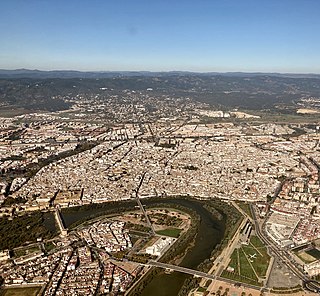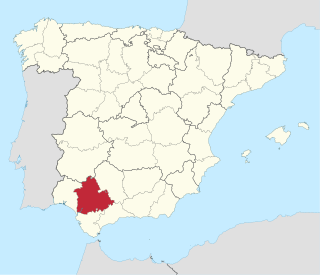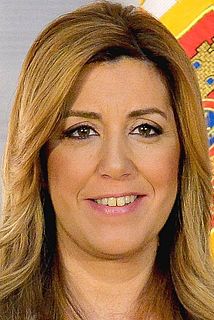
Andalusia is the southernmost autonomous community in Peninsular Spain. It is the most populous and the second largest autonomous community in the country. It is officially recognised as a "historical nationality". The territory is divided into eight provinces: Almería, Cádiz, Córdoba, Granada, Huelva, Jaén, Málaga, and Seville. Its capital city is Seville. The seat of the High Court of Justice of Andalusia is located in the city of Granada.

Córdoba, or Cordova in English, is a city in Andalusia, southern Spain, and the capital of the province of Córdoba. It is the third most populated municipality in Andalusia, after Seville and Málaga, and the 11th overall in the country.

Córdoba, also called Cordova in English, is one of the 50 provinces of Spain, in the north-central part of the autonomous community of Andalusia. It is bordered by the Andalusian provinces of Málaga, Seville, Jaén, and Granada, the Extremaduran province of Badajoz and the province of Ciudad Real, which is part of the autonomous community of Castile-La Mancha. Its area is 13,769 km2.

The Province of Seville is a province of southern Spain, in the western part of the autonomous community of Andalusia. It is bordered by the provinces of Málaga, Cádiz in the south, Huelva in the west, Badajoz in the north and Córdoba in the east. Seville is the province's as well as the Andalusian autonomous community's capital.

The Andalusians are a European ethnic group, native to Andalusia, an autonomous community in southern Spain. Andalusia's statute of autonomy defines Andalusians as the Spanish citizens who reside in any of the municipalities of Andalusia, as well as those Spaniards who reside abroad and had their last Spanish residence in Andalusia, and their descendants. Since reform in 2007, the Andalusian statute of autonomy identifies the territory as a historic nationality in the preamble. The Spanish Language Academy recognizes Andalusian Spanish as a set of diverse dialects.

The 2004 Andalusian regional election was held on Sunday, 14 March 2004, to elect the 7th Parliament of the autonomous community of Andalusia. All 109 seats in the Parliament were up for election. The election was held simultaneously with the 2004 Spanish general election.

The 1986 Andalusian regional election was held on Sunday, 22 June 1986, to elect the 2nd Parliament of the autonomous community of Andalusia. All 109 seats in the Parliament were up for election. The election was held simultaneously with the 1986 Spanish general election.

The 2015 Andalusian regional election was held on Sunday, 22 March 2015, to elect the 10th Parliament of the autonomous community of Andalusia. All 109 seats in the Parliament were up for election.
The following is a timeline of the history of the city of Málaga, Andalusia, Spain.
Bartolomé Ruiz González is a Spanish archaeologist who has been involved in cultural management in Andalucia since the late 1970s. He currently runs the Archaeological Ensemble of the Antequera Dolmens and is the director of the Royal Academy of Fine Arts of Antequera.
The Antequera Dolmens Site is a cultural heritage ensemble comprising three cultural monuments and 2 natural mountain features in and near the city of Antequera in Andalusia, Spain. The cultural institution responsible for its protection is the CADA. It was declared a World Heritage Site in 2016.

Cádiz is one of the eight constituencies represented in the Parliament of Andalusia, the regional legislature of the Autonomous Community of Andalusia. The constituency currently elects 15 deputies. Its boundaries correspond to those of the Spanish province of Cádiz. The electoral system uses the D'Hondt method and a closed-list proportional representation, with a minimum threshold of three percent.

Córdoba is one of the eight constituencies represented in the Parliament of Andalusia, the regional legislature of the Autonomous Community of Andalusia. The constituency currently elects 12 deputies. Its boundaries correspond to those of the Spanish province of Córdoba. The electoral system uses the D'Hondt method and a closed-list proportional representation, with a minimum threshold of three percent.

The Julio Romero de Torres Museum is a museum located in the city of Córdoba, Spain, which is notable for containing the largest collection of the famous Cordoban painter Julio Romero de Torres. It is located in the building of the old Hospital of la Caridad, which also houses the Museum of Fine Arts of Córdoba. The museum has been declared a Bien de Interés Cultural in the category of monument since 1962.

Adelante Andalucía was an electoral alliance formed by Podemos Andalusia, United Left/The Greens–Assembly for Andalusia, Andalusian Left and Andalusian Spring to contest the 2018 Andalusian regional election. The latter two parties were created in the wake of the dissolution of the Andalusian Party.
María del Carmen Laffón de la Escosura was a Spanish figurative painter and sculptor. She was a member of the Real Academia de Bellas Artes de San Fernando from 1998 until her death, and received numerous awards and honours, such as the Grand Cross of the Civil Order of Alfonso X, the Wise in 2017.

The Archaeological and Ethnological Museum of Córdoba is a museum in Córdoba, Spain. Owned by the Spanish State, its management has been transferred to the Ministry of Culture of the Junta of Andalusia.



























